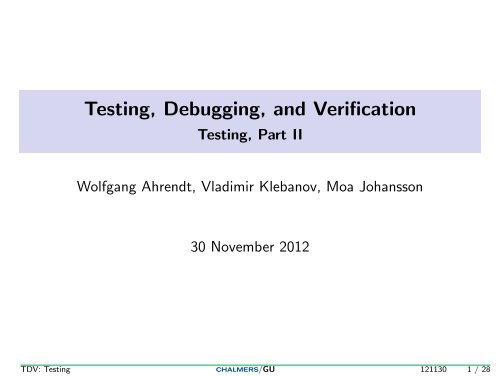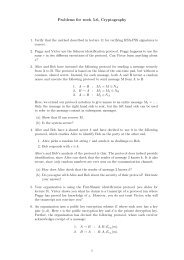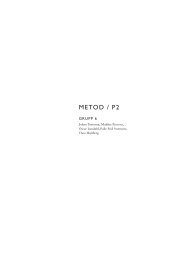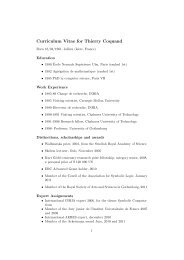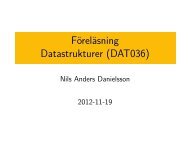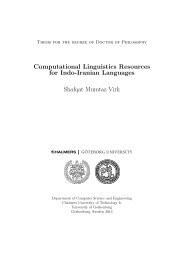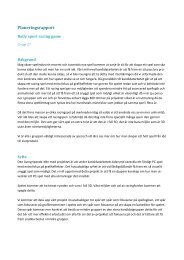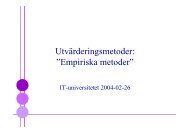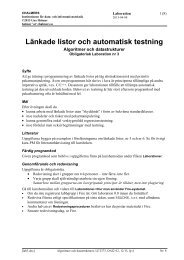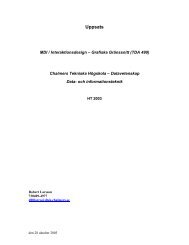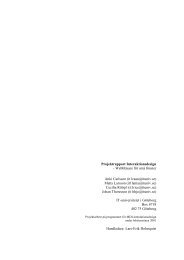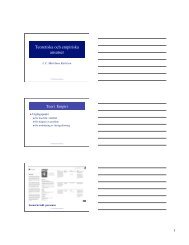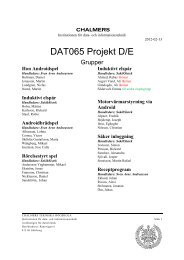Testing, Debugging, and Verification - Testing, Part II
Testing, Debugging, and Verification - Testing, Part II
Testing, Debugging, and Verification - Testing, Part II
You also want an ePaper? Increase the reach of your titles
YUMPU automatically turns print PDFs into web optimized ePapers that Google loves.
<strong>Testing</strong>, <strong>Debugging</strong>, <strong>and</strong> <strong>Verification</strong><br />
<strong>Testing</strong>, <strong>Part</strong> <strong>II</strong><br />
Wolfgang Ahrendt, Vladimir Klebanov, Moa Johansson<br />
30 November 2012<br />
TDV: <strong>Testing</strong> /GU 121130 1 / 28
<strong>Testing</strong> Levels Based on Software Activity<br />
Acceptance <strong>Testing</strong><br />
assess software with respect to user requirements<br />
System <strong>Testing</strong><br />
assess software with respect to system-level specification<br />
Integration <strong>Testing</strong><br />
assess software with respect to high-level design<br />
Unit <strong>Testing</strong><br />
assess software with respect to low-level unit design<br />
remarks:<br />
– terminology, <strong>and</strong> depth of this hierarchy, varies in literature<br />
TDV: <strong>Testing</strong> /GU 121130 2 / 28
V-Model<br />
Requirements Analysis<br />
Architectural Design<br />
(many variants!)<br />
Customer needs<br />
Choose components,<br />
connections<br />
Subsystem Design<br />
Structure, behaviour<br />
of subsystem<br />
Code!<br />
Implementation<br />
Unit <strong>Testing</strong><br />
User's/client's needs met?<br />
Assembled system<br />
meets spec?<br />
Does components<br />
work together?<br />
Test individual methods,<br />
classes<br />
Integration <strong>Testing</strong><br />
Acceptance <strong>Testing</strong><br />
System <strong>Testing</strong><br />
TDV: <strong>Testing</strong> /GU 121130 3 / 28
<strong>Testing</strong> Levels Based on Software Activity (cont’d)<br />
System <strong>Testing</strong> – testing system against specification of externally<br />
observable behaviour<br />
Integration <strong>Testing</strong> – testing interaction between modules<br />
Unit <strong>Testing</strong> – testing individual units of a system<br />
traditionally: unit = procedure<br />
in object-orientation (Java): unit = method<br />
Failures on higher levels less useful for debugging, as propagation from<br />
defect to failure is difficult to trace.<br />
This course focuses on lower level: unit testing<br />
TDV: <strong>Testing</strong> /GU 121130 4 / 28
Discussion: <strong>Testing</strong> Levels of a System for Printing<br />
Paychecks<br />
Staff Database<br />
Given name, looks up<br />
address, position.<br />
Name:<br />
Hours:<br />
Print Paycheck<br />
Payroll System<br />
calculates:<br />
salaries, taxes, bonus<br />
Print Paycheck<br />
Formats <strong>and</strong> prints<br />
paycheck<br />
Think of examples of:<br />
◮ System Tests<br />
◮ Integration Tests<br />
◮ Unit Tests<br />
TDV: <strong>Testing</strong> /GU 121130 5 / 28
Some examples of Tests<br />
◮ System Test<br />
◮ Enter data in GUI, does it print the correct paycheck, formatted as<br />
expected?<br />
◮ Integration Tests, e.g.<br />
◮ Payroll asks database for staff data, are values what’s expected?<br />
Maybe there are special characters (unexpected!).<br />
◮ Are paychecks formatted correctly for different kinds of printers?<br />
◮ Unit Tests, e.g.<br />
◮ Does payroll system compute correct tax-rate, bonus etc?<br />
◮ Does the Print Paycheck button react when clicked?<br />
◮ ...<br />
TDV: <strong>Testing</strong> /GU 121130 6 / 28
Regression <strong>Testing</strong><br />
Orthogonal to the above testing levels:<br />
Regression <strong>Testing</strong><br />
◮ <strong>Testing</strong> that is done after changes in the software.<br />
◮ Purpose:<br />
gain confidence that the change(s) did not cause (new) failures.<br />
◮ St<strong>and</strong>ard part of the maintenance phase of software development.<br />
E.g. Suppose Payroll subsystem is updated. Need to re-run tests (which<br />
ones?).<br />
TDV: <strong>Testing</strong> /GU 121130 7 / 28
Unit <strong>Testing</strong><br />
Rest of testing part of the course: focusing largely on unit testing<br />
recall: unit testing = procedure testing = (in oo) method testing<br />
major issues in unit testing:<br />
1. unit test cases (‘test cases’ in short)<br />
2. order in which to test <strong>and</strong> integrate units<br />
start with 1.<br />
TDV: <strong>Testing</strong> /GU 121130 8 / 28
Test Cases<br />
The science of testing is largely the science of test cases.<br />
TDV: <strong>Testing</strong> /GU 121130 9 / 28
What does a test case consists of?<br />
(to be refined later)<br />
Test case<br />
◮ Initialisation (of class instance <strong>and</strong> input arguments)<br />
◮ Call to the method under test.<br />
◮ Decision (oracle) whether the test succeeds or fails<br />
◮ two first parts seem enough for a test case,<br />
◮ but test oracle is vital for automated evaluation of test<br />
TDV: <strong>Testing</strong> /GU 121130 10 / 28
‘Success’ vs. ‘Failure’ of Tests<br />
What does it mean for a test to succed?<br />
... or fail?<br />
TDV: <strong>Testing</strong> /GU 121130 11 / 28
Test Cases, more precise<br />
Params,<br />
Input State<br />
Result,<br />
Final State<br />
I: (P, S )<br />
in Method<br />
(R, S )<br />
out<br />
m<br />
Oracle O<br />
More formally...<br />
A test case is a tuple 〈m, I, O〉 of method m, input I, <strong>and</strong> oracle O,<br />
where<br />
◮ m is the method under test<br />
◮ I is a tuple 〈P, Sin〉<br />
of call parameters P <strong>and</strong> initial state Sin<br />
◮ O(R, Sout) ↦→ {pass, fail}<br />
is a function on return value R <strong>and</strong> final state Sout, telling whether<br />
they comply with correct behaviour<br />
TDV: <strong>Testing</strong> /GU 121130 12 / 28<br />
Yes!<br />
No!
Test Set<br />
A test set TS m for a (Java) method m consists of n test cases:<br />
TS m = {〈m, I1, O1〉, . . . , 〈m, In, On〉}<br />
In general, Oi is specific for each test case!<br />
TDV: <strong>Testing</strong> /GU 121130 13 / 28
Test Suite<br />
A test suite for methods m1, . . . , mk is a union of corresponding test sets:<br />
TS m1 ∪ . . . ∪ TS mk<br />
TDV: <strong>Testing</strong> /GU 121130 14 / 28
Test Oracle, Remarks<br />
While O is in general specific for each <strong>and</strong> every test case, it is desirable<br />
to go beyond.<br />
◮ Desirable to have, for each method m, one uniform oracle O m .<br />
◮ Then, a test suit is:<br />
TS m = {〈m, I1, O m 〉, . . . , 〈m, In, O m 〉}<br />
◮ Moreover, desirable to have such uniform oracles generated<br />
automatically.<br />
These issues not addressed in the following,<br />
but in ‘Test Case Generation’ part of the course.<br />
TDV: <strong>Testing</strong> /GU 121130 15 / 28
Automated <strong>and</strong> Repeatable <strong>Testing</strong><br />
Basic idea: write code that performs the tests.<br />
◮ By using a tool you can automatically run a large collection of tests<br />
◮ The testing code can be integrated into the actual code, thus stored<br />
in an organised way<br />
◮ side-effect: documentation<br />
◮ After debugging, the tests are rerun to check if failure is gone<br />
◮ Whenever code is extended, all old test cases can be rerun to check<br />
that nothing is broken (regression testing)<br />
TDV: <strong>Testing</strong> /GU 121130 16 / 28
Automated <strong>and</strong> Repeatable <strong>Testing</strong> (cont’d)<br />
We will use JUnit for writing <strong>and</strong> running the test cases.<br />
JUnit: small tool offering<br />
◮ some functionality repeatedly needed when writing test cases<br />
◮ a way to annotate methods as being test cases<br />
◮ a way to run <strong>and</strong> evaluate test cases automatically in a batch<br />
TDV: <strong>Testing</strong> /GU 121130 17 / 28
JUnit<br />
◮ Java testing framework to write <strong>and</strong> run automated tests<br />
◮ JUnit features include:<br />
◮ Assertions for testing expected results<br />
◮ Annotations to designate test cases<br />
◮ Sharing of common test data<br />
◮ Graphical <strong>and</strong> textual test runners<br />
◮ JUnit is widely used in industry<br />
◮ JUnit used from comm<strong>and</strong> line or within an IDE (e.g., Eclipse)<br />
(Demo)<br />
TDV: <strong>Testing</strong> /GU 121130 18 / 28
Basic JUnit usage<br />
public c l a s s Ex1 {<br />
public s t a t i c int find_min ( int [] a) {<br />
int x, i;<br />
x = a [0];<br />
for (i = 1; i < a. length ;i ++) {<br />
i f (a[i] < x) x = a[i];<br />
}<br />
return x;<br />
}<br />
...<br />
TDV: <strong>Testing</strong> /GU 121130 19 / 28
Basic JUnit usage<br />
continued from prev page<br />
...<br />
public s t a t i c int [] insert ( int [] x, int n) {<br />
int [] y = new int [x. length + 1];<br />
int i;<br />
for (i = 0; i < x. length ; i ++) {<br />
i f (n < x[i]) break;<br />
y[i] = x[i];<br />
}<br />
y[i] = n;<br />
for (; i < x. length ; i ++) {<br />
y[i +1] = x[i];<br />
}<br />
return y;<br />
}<br />
}<br />
TDV: <strong>Testing</strong> /GU 121130 20 / 28
Basic JUnit usage<br />
JUnit can test for expected return values.<br />
public c l a s s Ex1Test {<br />
@Test public void test_find_min_1 () {<br />
int [] a = {5 , 1, 7};<br />
int res = Ex1 . find_min (a);<br />
assertTrue( res == 1);<br />
}<br />
}<br />
@Test public void test_insert_1 () {<br />
int [] x = {2 , 7};<br />
int n = 6;<br />
int [] res = Ex1 . insert (x, n);<br />
int [] expected = {2 , 6, 7};<br />
assertTrue( Arrays . equals ( expected , res ));<br />
}<br />
TDV: <strong>Testing</strong> /GU 121130 21 / 28
<strong>Testing</strong> for Exceptions<br />
JUnit can test for expected exceptions<br />
@Test (expected= IndexOutOfBoundsException . c l a s s )<br />
public void outOfBounds () {<br />
new ArrayList < Object >() . get (1) ;<br />
}<br />
expected declares that outOfBounds() should throw an<br />
IndexOutOfBoundsException.<br />
If it does<br />
◮ not throw any exception, or<br />
◮ throw a different exception<br />
the test fails.<br />
TDV: <strong>Testing</strong> /GU 121130 22 / 28
Compile <strong>and</strong> Run JUnit test class<br />
Alt.<br />
◮ JUnit plugin in Eclipse IDE:<br />
Right click on your project (or choose when creating project):<br />
Build Path → Add Libraries... → Choose JUnit 4.<br />
◮ Run the tester class as usual in Eclipse.<br />
◮ Compile test class:<br />
javac -cp .:pathToJunitJarFile Ex1Test.java<br />
◮ To run all methods annotated with @Test in a class:<br />
java -cp .:pathToJunitJarFile<br />
org.junit.runner.JUnitCore Ex1Test<br />
(under Windows: ‘;’ instead of ‘:’)<br />
TDV: <strong>Testing</strong> /GU 121130 23 / 28
Reflection: Extreme <strong>Testing</strong><br />
◮ JUnit designed for Extreme <strong>Testing</strong> paradigm<br />
◮ Extreme <strong>Testing</strong> part of Extreme Programming<br />
(but not depending on that)<br />
TDV: <strong>Testing</strong> /GU 121130 24 / 28
Reflection: Extreme <strong>Testing</strong> (cont’d)<br />
A few words Extreme Programming<br />
(no introduction here, but see [Myers], Chapter 8)<br />
◮ Extreme Programming (XP) invented by Beck (co-author of JUnit)<br />
◮ Most popular agile development process<br />
◮ Must create tests first, then create code basis<br />
◮ Must run unit tests for every incremental code change<br />
◮ Motivation:<br />
◮ oo programming allows rapid development<br />
◮ still, quality is not guaranteed<br />
◮ aim of XP: create quality programs in short time frames<br />
◮ XP relies heavily on unit <strong>and</strong> acceptance testing<br />
TDV: <strong>Testing</strong> /GU 121130 25 / 28
Extreme Unit <strong>Testing</strong><br />
benefits:<br />
modules (classes) must have unit tests before coding begins<br />
◮ You gain confidence that code will meet specification.<br />
◮ You better underst<strong>and</strong> specification <strong>and</strong> requirements.<br />
◮ You express end result before you start coding.<br />
◮ You may implement simple designs <strong>and</strong> optimise later<br />
while reducing the risk of breaking the specification.<br />
TDV: <strong>Testing</strong> /GU 121130 26 / 28
Extreme <strong>Testing</strong> Example: Class Money<br />
c l a s s Money {<br />
private int amount ;<br />
private Currency currency ;<br />
}<br />
public Money ( int amount , Currency currency ) {<br />
t h i s . amount = amount ;<br />
t h i s . currency = currency ;<br />
}<br />
public Money add( Money m) {<br />
// NO IMPLEMENTATION YET, WRITE TEST FIRST<br />
}<br />
Demo in Eclipse.<br />
TDV: <strong>Testing</strong> /GU 121130 27 / 28
Literature related to this Lecture<br />
Myers see course literature.<br />
AmmannOffutt see course literature.<br />
Beizer Boris Beizer: Software <strong>Testing</strong> Techniques.<br />
Van Nostr<strong>and</strong> Reinhold, 2nd edition, 1990.<br />
TDV: <strong>Testing</strong> /GU 121130 28 / 28


